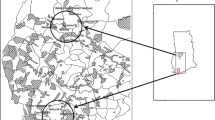Abstract
Increasing population in the forest zone of Cameroon has led to reduction of fallow periods and to diminution of per capita cropping land area. Alley farming is a promising technology for the zone; however, its large scale adoption depends on host of factors of which an important one is tree and land tenure. For this reason, a study was conducted in 1990 to determine implication of national land legislation and customary land and tree tenure on the adoption of alley farming in the forest zone of Cameroon.
Despite national laws purposing to regulate land and tree use, ownership rights to land and trees are largely determined by customary tenure rules. According to the forest zone customs, land is passed on from father to son when the father dies. Owners of inherited lands have full rights on lands and these rights are rarely revoked. Women do not own lands but are allowed to crop any piece of their husband's land as long as they stay married. Despite the lack of land ownership, women might still readily adopt alley farming because they are primarily concerned about food crop production and the amount of land to be given to their sons in the future.
Similar content being viewed by others
References
Décret No 76/166 du 27 Avril 1976, fixant la modalité de gestion du domaine national. Journal Officiel du Cameroun. Avril 1976
Décret No 76/165 du 1 er Avril 1976 fixant les conditions d'obtention du Titre Foncier. Journal Officiel du Cameroun. Avril 1976
Décret No 83/169 du 27 Avril 1983 fixant le régime des forêts. Journal Officiel du Cameroun. Avril 1983
Francis P and Atta-Krah AN (1989) Sociological and ecological factors in technology adoption. Browse trees in Southwest Nigeria. Experimental Agriculture 25(1): 1–10
IRA/ICRAF (1988) Rapport annuel du Projet IRA/ICRAF. Institut de la Recherche Agronomique. Yaounde, Cameroun, 52 pp
Loi No 81/13 du 25 Novembre 1981 portant régime des forêts, de la faume et des pêches. Journal Officiel du Cameroun. Novembre 1981.
Ordonnance No 74/2 du 6 Juillet 1974 fixant le régime domanial. Journal Officiel du Cameroun. Juillet 1974.
Ordonnance No 74/1 du 6 Juillet 1974 fixant le régime foncier. Journal Officiel du Cameroun. Juillet 1974
Ridell J and Dickerman C (1986) Country profiles of Land Tenure. Africa 1986. Land Tenure Center Paper No. 127. Land Tenure Center, University of Wisconsin, Madison, USA
Titi-Nwell P (1982) Mbombok à la tête du lignage Basaa. In: Nature et formes de pouvoir dans les sociétés dites acéphales. Orstom, Paris
Tonye J, Ambassa-Kiki R and Nsangou M (1987) Description des systèmes d'utilisation des terres dans la zone forestière du Cameroun. Possibilités d'amélioration. Science et Technique 3(1): 31–43
Author information
Authors and Affiliations
Additional information
Study funded by the International Livestock Center for Africa (ILCA), Addis-Abeba, Ethiopia, and technically supervised by the Land Tenure Center (LTC), University of Wisconsin, Wisconsin USA.
Rights and permissions
About this article
Cite this article
Tonye, J., Meke-Me-Ze, C. & Titi-Nwel, P. Implications of national land legislation and customary land and tree tenure on the adoption of alley farming. Agroforest Syst 22, 153–160 (1993). https://doi.org/10.1007/BF00705144
Issue Date:
DOI: https://doi.org/10.1007/BF00705144




